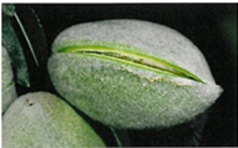Franz Niederholzer, UCCE Orchard Advisor, Colusa, Sutter and Yuba Cos.
Katherine Jarvis-Shean, UCCE Orchard Advisor Yolo, Solano, & Sacramento Cos.
Luke Milliron, UCCE Orchard Advisor, Butte, Glenn and Tehama Cos.
Please note that the following are general recommendations intended to help you keep track of regular practices in a busy time; the optimal timing for management practices may vary based on specific location and conditions.
- Navel orangeworm: Continue monitoring NOW and preparing for hull split. Almonds become vulnerable to NOW feeding/damage once hull split begins. Closely monitor hull split in the upper SW side of Nonpareil (NP) trees on field edges as those exposed nuts usually split ahead of the rest of the orchard. Depending where you are in the Sacramento Valley and specific orchard conditions, hull split may start as early as late June or as late as mid-July. Consider an edge spray once sound nuts in the edge NP trees reach Stage 2C of hull split (see photo below). The rest of the NP in the orchard should follow in roughly a week. Depending on the pollinizer(s) used, growers and their PCAs should decide if the first hull split spray (at Stage 2C for NP) should be a full spray or just on the NP.
- Ants: Timely harvest (100% hull split throughout the orchard) means less NOW risk. However, it also means longer drying times on the orchard floor and a higher chance for ant damage – if protein feeding ants are present. Survey ant colony concentration on the orchard floor 2 to 3 days after irrigation, counting active colonies in five 1,000 square foot areas (roughly a 5 x 6 tree rectangle). Confirm they are the undesirable (protein feeding) pavement or southern fire ants, not the harmless pyramid ants with the aid of these helpful photos. Use bait materials promptly after buying (product opened for 1-2 weeks no longer works) and apply to dry ground (at least one day after irrigation and two days before irrigation) for best results. Identification and key treatment details can be found on the UC IPM page for ants.
- Spider mites: Continue monitoring. Consider the presence of predators (sixspotted thrips and predator mites) in addition to the presence of spider mites when making treatment decisions. UC IPM guidelines use treatment thresholds of spider mite presence on 50% of leaves when predators are present, but only 30% of leaves if predators are absent. When spraying abamectin, use 1-2% (v/v) narrow range 415 oil (best leaf penetration) and spray at night (limits spray evaporation) to get the best mite control possible.
- Hull rot: Best control is from an integrated approach combining reduced irrigation between kernel fill and end of early hull split, moderate leaf N levels (no more than 2.6% N in summer leaf samples) and 1-2 fungicides in June or early July. See fungicide efficacy and timing tables in this newsletter.
- Monilinia hull rot: For best control of Monilinia hull rot, which presents as a tan lesion on the outside of the hull, spray in early June as hull split timing does not effectively control this hull rot pathogen.
- Rhizopus hull rot: For orchards with a history of Rhizopus hull rot (black spores), spray a fungicide at early hull split (first NOW timing).

Stage 2C of hull split. When sound nuts in the SW corner of tree tops look like this, this is THE critical timing for insecticide for navel orangeworm and fungicide for Rhizopus hull rot. When all the trees in the orchard have all the nuts that look at least like this from top to bottom, the orchard should be ready to harvest.
- Ground Squirrels: Ground squirrels switch from eating green vegetation to seeds and grains in late May. This means that June is the beginning of the window in which they will eat baited rodenticides. Test bait acceptance before use of rodenticide to avoid toxin shyness. For more on ground squirrel management, see these ground squirrel best management practices.
- Nitrogen: Finish up N applications in June.
- Potassium: Continue K applications if needed.
- Irrigation: If you have been able to run full irrigations during these drought conditions, a strategic irrigation deficit at the onset of hullsplit offers mutliple benefits. For Rhizopus hull rot management and a shorter, cleaner shake at harvest, reduce irrigation set length as kernel fill completes. Deep, heavy soil with micro-sprinkler or solid set irrigation have more soil water available and so respond more slowly to reduced irrigation compared to lighter soil with drip irrigation. For two to three weeks, beginning at the onset of hull split (late June or early July), SWP levels of 4 to 8 bars drier than the baseline (generally -14 to -18 bars) will promote hull split and uniform nut maturity leading to timely harvest. Learn more from our article on Advanced SWP Interpretation in Almond.
- Young Trees: Manage young tree irrigation carefully as summer heats up, especially with potted trees, to make sure water is wetting the rootzone. Find more on dealing with the challenge of irrigating potted trees from our article on Missing the Target: Why you Should Irrigate Potted Trees Directly onto Potting Media. Water sources (drippers and micro-sprinklers) should be moved away from the tree trunks after potted trees have been in the ground for a month.


Leave a Reply